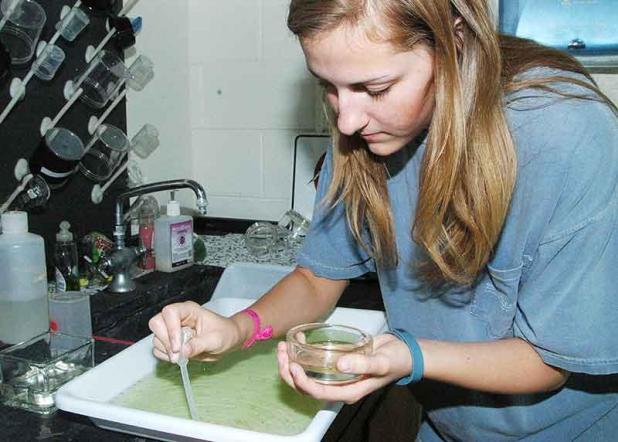
LSU AgCenter Photo
An LSU AgCenter researcher studies mosquitoes in this file photo. More recent research at LSU is focusing on the interplay between mosquitoes and climate in New Orleans.
Mosquitoes may help solve mosquito problems
BATON ROUGE – In autumn, as the heat becomes a bit more bearable and football season approaches, people begin to spend more time outdoors where they are sure to be plagued by that quintessential Louisiana nuisance—mosquitoes.
And mosquitoes are more than just an annual annoyance.
Mosquitoes are common pests and vectors for diseases. But what if more mosquitoes were actually the solution?
Rebeca De Jesus Crespo, an assistant professor and landscape ecologist in LSU’s College of the Coast & Environment, is exploring why virus-carrying mosquitoes proliferate in New Orleans and San Juan, Puerto Rico and how promoting mosquito diversity may reduce disease transmission.
And she is looking for New Orleans citizens who would like to assist in her research.
De Jesus Crespo was part of a team of scientists that explored how habitat alteration has led to flooding and water pollution problems in San Juan, Puerto Rico, and whether these factors could be related to increasingly common outbreaks of diseases such as dengue, Zika, and chikungunya (pronounced “CHIK-ən-GUN-yə”) there.
They found that unlike regular rainwater, flooding in these neighborhoods may have brought an influx of nutrients in the water, which were linked to higher virus concentrations in the mosquito vectors. I
n another study, De Jesus Crespo found that wetland cover helped to reduce temperatures in the city of San Juan, and that this was associated with lower cases of dengue in certain neighborhoods.
San Juan and New Orleans are similar in that both are metropolitan cities experiencing an increase in flooding, water pollution and urban heat islands.
Both cities contain yellow fever mosquitoes, the main mosquito vectors of Zika. Other species that could carry Zika are also present, including Asian tiger mosquitoes in New Orleans and Caribbean treehole mosquitoes in Puerto Rico.
While all three species can bite humans and other animals, yellow fever mosquitoes prefer to snack on humans, while the other two species are more opportunistic and bite other animals more often.
These mosquito species are natural competitors, and De Jesus Crespo believes that increasing the presence of Asian tiger mosquitoes (and Caribbean treehole mosquitoes) could reduce the population of yellow fever mosquitoes —the vector that is most likely to transmit viruses to humans. Currently, Asian tiger mosquitoes are the dominate species in North America and, presumably, New Orleans. De Jesus Crespo believes that may be why New Orleans does not experience Zika epidemics like those in San Juan, yet.
“New Orleans has more of a winter, unlike San Juan, and it gets too cold for yellow fever mosquitoes to survive that long here.
"But the question is whether, in the future, hotter temperatures due to climate change would lead to more favorable conditions for transmission from any of these vectors,” De Jesus Crespo said.
Yellow fever mosquitoes are better adapted to higher temperatures than Asian tiger mosquitoes. Therefore, if New Orleans were to become hotter and drier, that may tip the scales to favor yellow fever mosquitoes and increase the risk of Zika.
“If you combine that with other factors such as floods and water pollution, which also seem to favor the disease, then we may have an even bigger problem,” De Jesus Crespo said.
So, this August, De Jesus Crespo and her graduate student, Rachel Rogers, are going to visit local mosquito hot spots in New Orleans in order to map the mosquito populations of these two species.
“If we are able to say, ‘In this neighborhood the temperature gets really hot, there’s no tree cover, and it’s flood prone and so we got all these surges in nutrients and it just so happens that we have more abundance of yellow fever mosquitoes here than in other neighborhoods,’ then that’s data that we can use to make projections into the future to see how the risk could change,” De Jesus Crespo said.
They will work closely with the New Orleans Mosquito, Termite and Rodent Control Board to define their study sites, particularly flood prone neighborhoods, and they are hoping to find residents who are willing to help.
They plan to collect the mosquito data by placing traps in people’s homes that will help them characterize adult mosquito populations, and if the mosquitoes are feeding preferentially on humans or other animals.
They will also collect data on nutrients, flood risk, temperature and tree cover around the homes to determine if any of these traits are associated with mosquito trends.
If you live in New Orleans, and are interested in participating, please contact Rebeca De Jesus Crespo at rdejesuscrespo1@lsu.edu.
